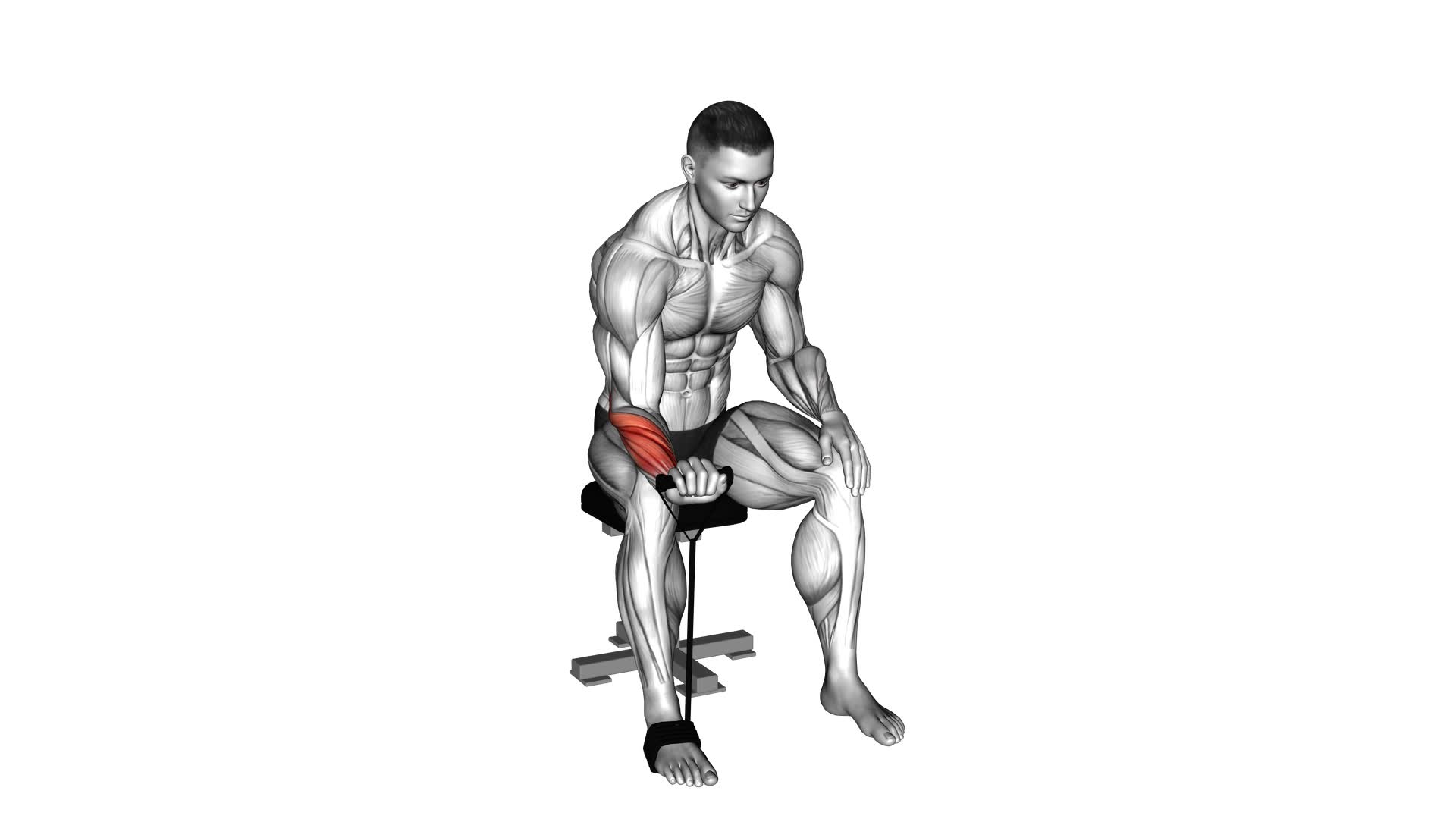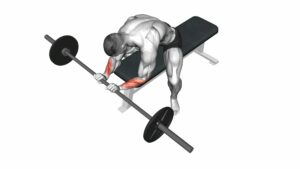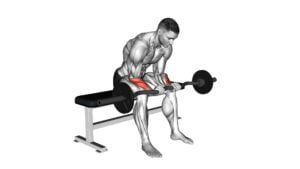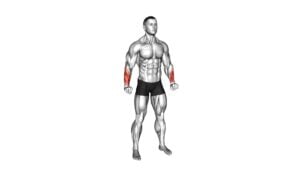Band Reverse Wrist Curl – Video Exercise Guide & Tips

Looking to strengthen your wrists and forearms? Check out the Band Reverse Wrist Curl – Video Exercise Guide & Tips.
Watch This Exercise Video
In this informative article, we'll show you how to properly perform this exercise using a resistance band. You'll learn the benefits, equipment needed, and common mistakes to avoid.
With our step-by-step instructions and helpful tips, you'll be on your way to maximizing results and improving your wrist and forearm strength in no time.
Let's get started!
Key Takeaways
- Band Reverse Wrist Curl improves grip strength and wrist stability.
- It targets forearm muscles effectively and contributes to forearm development and strength.
- Incorporating Band Reverse Wrist Curl in your training routine enhances overall performance and prevents plateaus in training.
- Proper form and technique, as well as choosing the appropriate resistance band, are crucial for maximizing results with Band Reverse Wrist Curl.
Benefits of Band Reverse Wrist Curl
To strengthen your forearm muscles, the Band Reverse Wrist Curl offers significant benefits, including improved grip strength and increased wrist stability. This exercise specifically targets the muscles in your forearms, helping to develop and strengthen them effectively.
By performing the Band Reverse Wrist Curl, you can enhance your grip strength, which is crucial for various activities such as weightlifting, rock climbing, and even everyday tasks like carrying groceries or opening jars. Strong forearm muscles enable you to maintain a firm grip on objects, reducing the risk of accidents and enhancing overall functionality in your daily life.
Additionally, this exercise helps to develop and define your forearm muscles, contributing to their overall size and strength. The Band Reverse Wrist Curl targets the extensor muscles in your forearms, which are responsible for extending your wrist and fingers. By repeatedly engaging these muscles, you can increase their endurance and power, leading to improved forearm development.
Incorporating the Band Reverse Wrist Curl into your routine can be beneficial for athletes, weightlifters, and individuals seeking to improve their overall forearm strength. Remember to start with lighter resistance bands and gradually increase the intensity as your muscles adapt. With consistent practice, you can enjoy the benefits of improved grip strength and forearm development.
Equipment Needed for Band Reverse Wrist Curl
To perform the band reverse wrist curl exercise, you'll need a resistance band. There are different band options available, such as loop bands or tube bands, which provide varying levels of resistance to challenge your wrists.
Band Options for Wrists
Choose the appropriate band resistance for your wrists to effectively perform the Band Reverse Wrist Curl exercise. Here are four options to consider:
- Light Resistance Band: This band is ideal for beginners or individuals with weaker wrists. It provides minimal resistance, allowing you to focus on proper form and technique.
- Medium Resistance Band: As you progress in your wrist strengthening journey, a medium resistance band is a great option. It offers more resistance to challenge your muscles and promote growth.
- Heavy Resistance Band: For those with advanced wrist strength, a heavy resistance band provides the necessary challenge to continue improving. It requires more effort and engages your muscles to a greater extent.
- Variable Resistance Band: This type of band allows you to adjust the resistance level by adding or removing bands. It's perfect for individuals who want to have more control over their wrist strengthening routine.
Remember to choose a band that suits your fitness level and gradually increase the resistance as your wrists become stronger.
Benefits of Wrist Curls
As you progress in your wrist strengthening journey with the appropriate band resistance, you can experience the benefits of wrist curls and improve your wrist strength and stability. Wrist curls are an effective way to target the muscles in your forearms and wrists, helping to increase grip strength and enhance overall performance.
By incorporating wrist curl variations into your workout routine, you can target different muscle groups and prevent plateaus in your training. Athletes, in particular, can benefit from wrist curls as they require a strong grip and wrist stability for various sports such as weightlifting, tennis, and golf.
Additionally, wrist curls can help reduce the risk of wrist injuries and improve dexterity, making them a valuable exercise for athletes in any sport.
Proper Form and Technique for Band Reverse Wrist Curl
To perform the Band Reverse Wrist Curl with proper form and technique, you need to focus on hand positioning and grip. Make sure your hands are parallel to the ground and your palms are facing down.
Choose a resistance band that provides enough tension to challenge your muscles but still allows you to maintain proper form throughout the exercise.
Lastly, be mindful of common mistakes like using your shoulders to assist in the movement or allowing your wrists to bend too far.
Hand Positioning and Grip
Hold the band with a firm grip, positioning your hands in the proper form for the band reverse wrist curl exercise. Here are four grip techniques and hand positioning tips to help you perform the exercise correctly:
- Start by placing your hands shoulder-width apart on the band, ensuring that your thumbs are facing upwards.
- Keep your wrists in a neutral position, avoiding any excessive bending or flexing.
- Maintain a tight grip on the band throughout the entire movement, squeezing it with your fingers and palms.
- Make sure there's enough tension in the band to provide resistance, but not too much that it causes discomfort or limits your range of motion.
Resistance Band Selection
When selecting a resistance band for the band reverse wrist curl exercise, it's important to choose one that provides enough tension without causing discomfort or limiting your range of motion.
Resistance bands come in different levels of resistance, typically categorized by color or strength. For wrist strength training, it's recommended to start with a lighter resistance band and gradually increase as your strength improves.
The band should be securely anchored to a stable object such as a door handle or a sturdy post. Make sure the band isn't too loose or too tight, allowing you to perform the exercise with proper form and without compromising your safety.
Now that you know how to select the right resistance band, let's move on to the common mistakes to avoid in the band reverse wrist curl exercise.
Common Mistakes to Avoid
Ensure proper form and technique by avoiding common mistakes during the band reverse wrist curl exercise. To get the most out of this exercise and prevent injury, keep the following tips in mind:
- Avoid using excessive weight: Using a band that's too heavy can strain your wrists and compromise your form. Start with a lighter resistance and gradually increase as you gain strength.
- Maintain proper wrist alignment: Keep your wrists straight and in line with your forearms throughout the movement. Avoid bending or extending your wrists excessively.
- Control the movement: Slowly lower your hands back to the starting position after each repetition. Avoid letting the band pull your hands back quickly, as this can lead to wrist strain.
- Consider wrist curl modifications or alternatives: If you have wrist pain or difficulty performing the exercise, try using dumbbells or a wrist roller instead. These alternatives can provide a different grip and reduce stress on the wrists.
Progressions and Variations of Band Reverse Wrist Curl
To enhance your wrist strength and flexibility, try incorporating various progressions and variations into your Band Reverse Wrist Curl routine. Progressions are a way to gradually increase the difficulty of an exercise, while variations offer different ways to target the same muscles.
One progression you can try is using a heavier resistance band. This will challenge your wrist muscles even more and help you build strength. You can also increase the number of repetitions or sets you do to make the exercise more challenging. Another option is to slow down the movement and focus on the eccentric phase of the exercise, where you lower your hand back to the starting position. This will further engage your wrist muscles and improve control.
When it comes to variations, you can experiment with different hand positions. For example, you can try doing the exercise with your palms facing down or up, or even with one hand at a time. These variations will target slightly different areas of your wrists and forearms, providing a well-rounded workout.
By incorporating progressions and variations into your Band Reverse Wrist Curl routine, you can continue to challenge your muscles and make continuous progress.
Now let's move on to the next section and discuss common mistakes to avoid during the band reverse wrist curl.
Common Mistakes to Avoid During Band Reverse Wrist Curl
To avoid common mistakes during the Band Reverse Wrist Curl, focus on maintaining proper form and avoiding unnecessary movements. Here are some common wrist curl mistakes to be aware of:
- Incorrect hand positioning: Make sure your hands are positioned correctly on the band. Your palms should be facing down and your fingers should be spread apart, gripping the band firmly. This will ensure proper engagement of the wrist muscles.
- Using too much momentum: Avoid swinging your arms or using momentum to lift the band. This can take the focus away from the wrist muscles and lead to ineffective results. Instead, focus on controlled and slow movements to maximize the benefits of the exercise.
- Not maintaining a neutral wrist: It's important to keep your wrist in a neutral position throughout the movement. Avoid bending your wrist too much or allowing it to collapse. This can put unnecessary strain on the joint and increase the risk of injury.
- Neglecting proper breathing: Don't forget to breathe properly during the exercise. Inhale as you lower the band and exhale as you lift it. This will help stabilize your core and enhance your overall performance.
Tips for Maximizing Results With Band Reverse Wrist Curl
To optimize your results with the Band Reverse Wrist Curl, focus on maximizing the intensity and incorporating progressive overload into your training routine. By doing so, you can effectively maximize wrist strength and improve grip strength.
First and foremost, it's important to choose the right resistance band for your current strength level. Using a band that's too light may not provide enough resistance to stimulate muscle growth, while using a band that's too heavy could lead to improper form and potential injury. Find a band that challenges you but still allows you to perform the exercise with proper technique.
Next, pay attention to your form. Keep your wrists straight throughout the movement and avoid using momentum to lift the band. By maintaining proper form, you can effectively target the muscles in your forearms and wrists, leading to better results.
Incorporating progressive overload is another key aspect of maximizing your results. This involves gradually increasing the resistance or repetitions over time to continually challenge your muscles. Start with a moderate resistance band and gradually work your way up to heavier bands as you become stronger.
Lastly, consistency is key. Incorporate the Band Reverse Wrist Curl into your regular training routine and aim to perform it at least two to three times a week. Remember to rest and recover adequately between sessions to allow your muscles to repair and grow stronger.
Frequently Asked Questions
How Many Sets and Reps Should I Do for the Band Reverse Wrist Curl Exercise?
To determine the number of sets and reps for the band reverse wrist curl exercise, it's important to consider your fitness goals and current strength level. Start with 2-3 sets of 12-15 reps and gradually increase the intensity as you get stronger.
Band reverse wrist curl variations can help improve grip strength, wrist stability, and forearm muscle development. Adding this exercise to your routine can enhance overall upper body strength and performance in various sports and activities.
Can I Use Dumbbells Instead of Resistance Bands for the Reverse Wrist Curl?
Yes, you can use dumbbells instead of resistance bands for the reverse wrist curl exercise.
However, it's important to note that resistance bands have certain benefits, such as providing constant tension throughout the entire range of motion.
Dumbbells can still be effective for targeting the wrist extensors, but using resistance bands can enhance the workout by intensifying the resistance and engaging the muscles in a different way.
Is the Band Reverse Wrist Curl Suitable for Beginners or Should I Have Some Prior Strength Training Experience?
The Band Reverse Wrist Curl is a great exercise for beginners looking to strengthen their wrists and forearms. However, it's important to have some prior strength training experience before attempting this exercise. Building up strength in the wrists and forearms through other exercises will help prevent injury and ensure proper form.
Can the Band Reverse Wrist Curl Help With Wrist Pain or Injury Rehabilitation?
The band reverse wrist curl is an exercise that can help with wrist pain relief and injury rehabilitation. By targeting the muscles in your wrists and forearms, this exercise can strengthen and stabilize the affected area, promoting healing and reducing pain.
Incorporating wrist exercises like the band reverse wrist curl into your routine can have numerous benefits, such as improving grip strength and flexibility, preventing future injuries, and enhancing overall wrist function.
Are There Any Modifications or Alternatives to the Band Reverse Wrist Curl Exercise for Those With Limited Wrist Flexibility?
If you have limited wrist flexibility, there are modifications and alternatives to the band reverse wrist curl exercise. These options can help you still work on strengthening your wrists without putting too much strain on them.
It's important to find exercises that allow you to move your wrists comfortably and within your range of motion. By modifying or trying alternative exercises, you can still achieve your fitness goals while taking care of your wrists.
Conclusion
In conclusion, the band reverse wrist curl is a beneficial exercise that targets the muscles in your forearms and helps improve grip strength. It requires minimal equipment and can be easily incorporated into your workout routine.
By following proper form and technique, avoiding common mistakes, and progressing with variations, you can maximize the results of this exercise.
So, grab a resistance band and start incorporating band reverse wrist curls into your fitness routine for stronger forearms.

Author
Years ago, the spark of my life’s passion ignited in my mind the moment I stepped into the local gym for the first time. The inaugural bead of perspiration, the initial endeavor, the very first surge of endorphins, and a sense of pride that washed over me post-workout marked the beginning of my deep-seated interest in strength sports, fitness, and sports nutrition. This very curiosity blossomed rapidly into a profound fascination, propelling me to earn a Master’s degree in Physical Education from the Academy of Physical Education in Krakow, followed by a Sports Manager diploma from the Jagiellonian University. My journey of growth led me to gain more specialized qualifications, such as being a certified personal trainer with a focus on sports dietetics, a lifeguard, and an instructor for wellness and corrective gymnastics. Theoretical knowledge paired seamlessly with practical experience, reinforcing my belief that the transformation of individuals under my guidance was also a reflection of my personal growth. This belief holds true even today. Each day, I strive to push the boundaries and explore new realms. These realms gently elevate me to greater heights. The unique combination of passion for my field and the continuous quest for growth fuels my drive to break new ground.







